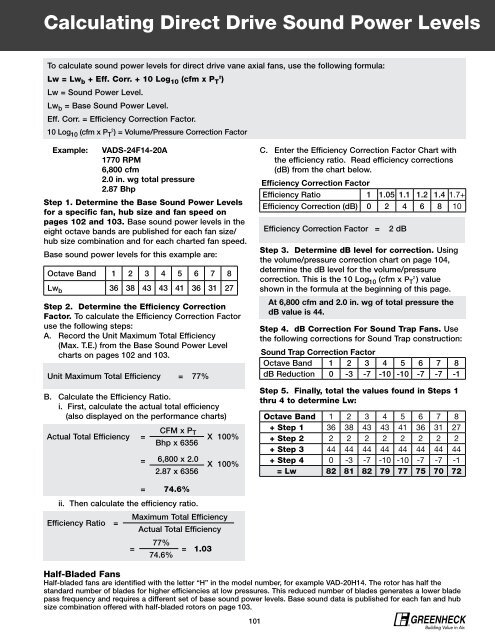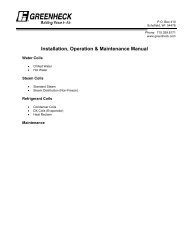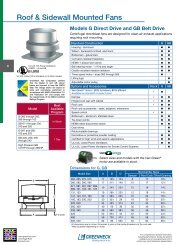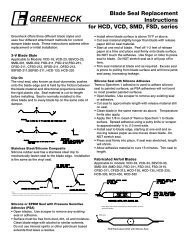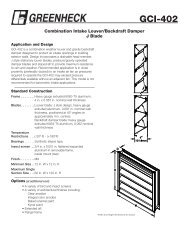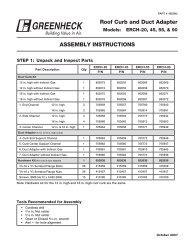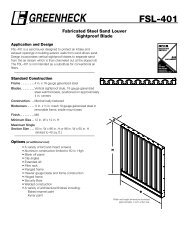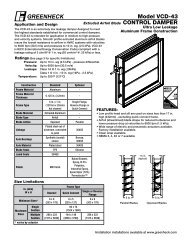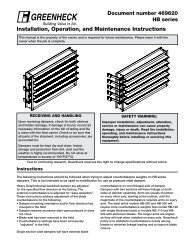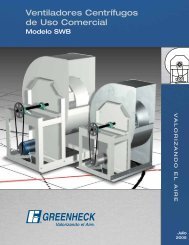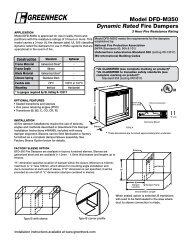Vane Axial Fans - Greenheck
Vane Axial Fans - Greenheck
Vane Axial Fans - Greenheck
You also want an ePaper? Increase the reach of your titles
YUMPU automatically turns print PDFs into web optimized ePapers that Google loves.
®<br />
Calculating Direct Drive Sound Power Levels<br />
To calculate sound power levels for direct drive vane axial fans, use the following formula:<br />
Lw = Lw b + Eff. Corr. + 10 Log 10 (cfm x P T2<br />
)<br />
Lw = Sound Power Level.<br />
Lw b = Base Sound Power Level.<br />
Eff. Corr. = Efficiency Correction Factor.<br />
2<br />
10 Log 10 (cfm x P T ) = Volume/Pressure Correction Factor<br />
Example:<br />
VADS-24F14-20A<br />
1770 RPM<br />
6,800 cfm<br />
2.0 in. wg total pressure<br />
2.87 Bhp<br />
Step 1. Determine the Base Sound Power Levels<br />
for a specific fan, hub size and fan speed on<br />
pages 102 and 103. Base sound power levels in the<br />
eight octave bands are published for each fan size/<br />
hub size combination and for each charted fan speed.<br />
Base sound power levels for this example are:<br />
Octave Band 1 2 3 4 5 6 7 8<br />
Lw b 36 38 43 43 41 36 31 27<br />
Step 2. Determine the Efficiency Correction<br />
Factor. To calculate the Efficiency Correction Factor<br />
use the following steps:<br />
A. Record the Unit Maximum Total Efficiency<br />
(Max. T.E.) from the Base Sound Power Level<br />
charts on pages 102 and 103.<br />
Unit Maximum Total Efficiency = 77%<br />
B. Calculate the Efficiency Ratio.<br />
i. First, calculate the actual total efficiency<br />
(also displayed on the performance charts)<br />
Actual Total Efficiency =<br />
CFM x P T<br />
X 100%<br />
Bhp x 6356<br />
= 6,800 x 2.0 X 100%<br />
2.87 x 6356<br />
C. Enter the Efficiency Correction Factor Chart with<br />
the efficiency ratio. Read efficiency corrections<br />
(dB) from the chart below.<br />
Efficiency Correction Factor<br />
Efficiency Ratio 1 1.05 1.1 1.2 1.4 1.7+<br />
Efficiency Correction (dB) 0 2 4 6 8 10<br />
Efficiency Correction Factor = 2 dB<br />
Step 3. Determine dB level for correction. Using<br />
the volume/pressure correction chart on page 104,<br />
determine the dB level for the volume/pressure<br />
2<br />
correction. This is the 10 Log 10 (cfm x P T ) value<br />
shown in the formula at the beginning of this page.<br />
At 6,800 cfm and 2.0 in. wg of total pressure the<br />
dB value is 44.<br />
Step 4. dB Correction For Sound Trap <strong>Fans</strong>. Use<br />
the following corrections for Sound Trap construction:<br />
Sound Trap Correction Factor<br />
Octave Band 1 2 3 4 5 6 7 8<br />
dB Reduction 0 -3 -7 -10 -10 -7 -7 -1<br />
Step 5. Finally, total the values found in Steps 1<br />
thru 4 to determine Lw:<br />
Octave Band 1 2 3 4 5 6 7 8<br />
+ Step 1 36 38 43 43 41 36 31 27<br />
+ Step 2 2 2 2 2 2 2 2 2<br />
+ Step 3 44 44 44 44 44 44 44 44<br />
+ Step 4 0 -3 -7 -10 -10 -7 -7 -1<br />
= Lw 82 81 82 79 77 75 70 72<br />
= 74.6%<br />
ii. Then calculate the efficiency ratio.<br />
Maximum Total Efficiency<br />
Efficiency Ratio =<br />
Actual Total Efficiency<br />
=<br />
77% = 1.03<br />
74.6%<br />
Half-Bladed <strong>Fans</strong><br />
Half-bladed fans are identified with the letter “H” in the model number, for example VAD-20H14. The rotor has half the<br />
standard number of blades for higher efficiencies at low pressures. This reduced number of blades generates a lower blade<br />
pass frequency and requires a different set of base sound power levels. Base sound data is published for each fan and hub<br />
size combination offered with half-bladed rotors on page 103.<br />
101


